#ibm power systems
Explore tagged Tumblr posts
Text

UK 1998
#UK1998#FOX COMPUTER SYSTEMS#HARDWARE#IBM#FOX FAMILY MULTIMEDIA PC#FOX POWER MULTIMEDIA PC#FOX PROFESSIONAL MULTIMEDIA PC
26 notes
·
View notes
Text
AS400 iSeries (IBM i) – A Comprehensive Overview
How many programmers/developers around you are familiar with or interested in learning about the AS/400 computer system? Few, or even none, may be aware of its origins. Despite being considered outdated, the latest IBM Power systems or IBM iSeries systems are still utilized by many organizations due to their robust and reliable system architectures. Although the AS400 is considered a legacy system, its modified versions have excellent operating systems and documentation.
Read more - https://programmers.io/blog/everything-to-know-about-ibmi-as400-i-series/
0 notes
Text
The discovery that hypnotic states could be used for market regulatory purposes was nothing short of a revolution for the Federal Reseve. in June 1968, Initial experiments with "financial clairvoyance" were conducted.
The original methodology was fairly simple: fully trained subjects would be placed in a sensory deprivation tank and undergo hypnosonic neuro-induction to the point of sub-finantial emanation. Subjects would remain attuned for 24 hours, at which point they would be de-emanated, and their experiences recorded via interview.
This methodology proved to be an expensive disaster. Repeated cycles of emanation and de-emanation had a catastrophic effect on mental cohesion. On average, subjects would begin to show signs of neuro-depatterning within the first 50 dives, and would slip into permanent catatonia by 350 dives.
Additionally, recovered documents from the period show that information from a single Plutophant was only accurate to within a 2.2i Murdoch deviations, and the interview method introduced a further 5.1i of uncertainty. While experimental attempts to record brain activity directly were underway, technology was primitive, often harmful to the subject, or necessitated invasive surgical modification. Even then, transchronological brain activity proved uniquely difficult to record.
Then, a breakthrough.
The 1960 nationwide upgrade of the minuteman nuclear system was underway, which created a surplus of IBM Drum Storage Drives. Drives that were largely donated to research institutions under the purview of project Clover. With some modifications, the cyclical nature these drum drives proved to be ideal for recording changes in transchronological neuropatterning.
These "Radio-Magnetic Neurological Sensory Arrays" were the predecessor to the modern neuroscope. The first production example, the IBM Y-2, was the size of an entire room, requiring enormous amounts of power and several trained technicians to process the thoughts of a single Plutophant into a human-readable form.
Study is ongoing.
685 notes
·
View notes
Text
You might have heard of 32-bit and 64-bit applications before, and if you work with older software, maybe 16-bit and even 8-bit computers. But what came before 8-bit? Was it preceded by 4-bit computing? Were there 2-bit computers? 1-bit? Half-bit?
Well outside that one AVGN meme, half-bit isn't really a thing, but the answer is a bit weirder in other ways! The current most prominent CPU designs come from Intel and AMD, and Intel did produce 4-bit, 8-bit, 16-bit, 32-bit and 64-bit microprocessors (although 4-bit computers weren't really a thing). But what came before 4-bit microprocessors?
Mainframes and minicomputers did. These were large computers intended for organizations instead of personal use. Before microprocessors, they used transistorized integrated circuits (or in the early days even vacuum tubes) and required a much larger space to store the CPU.
And what bit length did these older computers have?
A large variety of bit lengths.
There were 16-bit, 32-bit and 64-bit mainframes/minicomputers, but you also had 36-bit computers (PDP-10), 12-bit (PDP-8), 18-bit (PDP-7), 24-bit (ICT 1900), 48-bit (Burroughs) and 60-bit (CDC 6000) computers among others. There were also computers that didn't use binary encoding to store numbers, such as decimal computers or the very rare ternary computers (Setun).
And you didn't always evolve by extending the bit length, you could upgrade from an 18-bit computer to a more powerful 16-bit computer, which is what the developers of early UNIX did when they switched over from the PDP-7 to the PDP-11, or offer 32-bit over 36-bit, which happened when IBM phased out the IBM 7090 in favor of the the System/360 or DEC phased out the PDP-10 in favor of the VAX.
154 notes
·
View notes
Text
The paradox of choice screens
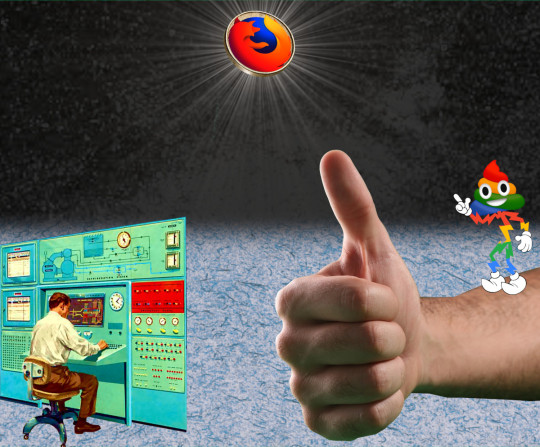
I'm coming to BURNING MAN! On TUESDAY (Aug 27) at 1PM, I'm giving a talk called "DISENSHITTIFY OR DIE!" at PALENQUE NORTE (7&E). On WEDNESDAY (Aug 28) at NOON, I'm doing a "Talking Caterpillar" Q&A at LIMINAL LABS (830&C).

It's official: the DOJ has won its case, and Google is a convicted monopolist. Over the next six months, we're gonna move into the "remedy" phase, where we figure out what the court is going to order Google to do to address its illegal monopoly power:
https://pluralistic.net/2024/08/07/revealed-preferences/#extinguish-v-improve
That's just the beginning, of course. Even if the court orders some big, muscular remedies, we can expect Google to appeal (they've already said they would) and that could drag out the case for years. But that can be a feature, not a bug: a years-long appeal will see Google on its very best behavior, with massive, attendant culture changes inside the company. A Google that's fighting for its life in the appeals court isn't going to be the kind of company that promotes a guy whose strategy for increasing revenue is to make Google Search deliberately worse, so that you will have to do more searches (and see more ads) to get the info you're seeking:
https://pluralistic.net/2024/04/24/naming-names/#prabhakar-raghavan
It's hard to overstate how much good stuff can emerge from a company that's mired itself in antitrust hell with extended appeals. In 1982, IBM wriggled off the antitrust hook after a 12-year fight that completely transformed the company's approach to business. After more than a decade of being micromanaged by lawyers who wanted to be sure that the company didn't screw up its appeal and anger antitrust enforcers, IBM's executives were totally transformed. When the company made its first PC, it decided to use commodity components (meaning anyone could build a similar PC by buying the same parts), and to buy its OS from an outside vendor called Micros-Soft (meaning competing PCs could use the same OS), and it turned a blind eye to the company that cloned the PC ROM, enabling companies like Dell, Compaq and Gateway to enter the market with "PC clones" that cost less and did more than the official IBM PC:
https://www.eff.org/deeplinks/2019/08/ibm-pc-compatible-how-adversarial-interoperability-saved-pcs-monopolization
The big question, of course, is whether the court will order Google to break up, say, by selling off Android, its ad-tech stack, and Chrome. That's a question I'll address on another day. For today, I want to think about how to de-monopolize browsers, the key portal to the internet. The world has two extremely dominant browsers, Safari and Chrome, and each of them are owned by an operating system vendor that pre-installs their own browser on their devices and pre-selects them as the default.
Defaults matter. That's a huge part of Judge Mehta's finding in the Google case, where the court saw evidence from Google's own internal research suggesting that people rarely change defaults, meaning that whatever the gadget does out of the box it will likely do forever. This puts a lie to Google's longstanding defense of its monopoly power: "choice is just a click away." Sure, it's just a click away – a click, you're pretty sure no one is ever going to make.
This means that any remedy to Google's browser dominance is going to involve a lot of wrangling about defaults. That's not a new wrangle, either. For many years, regulators and tech companies have tinkered with "choice screens" that were nominally designed to encourage users to try out different browsers and brake the inertia of the big two browsers that came bundled with OSes.
These choice screens have a mixed record. Google's 2019 Android setup choice screen for the European Mobile Application Distribution Agreement somehow managed to result in the vast majority of users sticking with Chrome. Microsoft had a similar experience in 2010 with BrowserChoice.eu, its response to the EU's 2000s-era antitrust action:
https://en.wikipedia.org/wiki/BrowserChoice.eu
Does this mean that choice screens don't work? Maybe. The idea of choice screens comes to us from the "choice architecture" world of "nudging," a technocratic pseudoscience that grew to prominence by offering the promise that regulators could make big changes without having to do any real regulating:
https://verfassungsblog.de/nudging-after-the-replication-crisis/
Nudge research is mired in the "replication crisis" (where foundational research findings turn out to be nonreplicable, due to bad research methodology, sloppy analysis, etc) and nudge researchers keep getting caught committing academic fraud:
https://www.ft.com/content/846cc7a5-12ee-4a44-830e-11ad00f224f9
When the first nudgers were caught committing fraud, more than a decade ago, they were assumed to be outliers in an otherwise honest and exciting field:
https://www.npr.org/2016/10/01/496093672/power-poses-co-author-i-do-not-believe-the-effects-are-real
Today, it's hard to find much to salvage from the field. To the extent the field is taken seriously today, it's often due to its critics repeating the claims of its boosters, a process Lee Vinsel calls "criti-hype":
https://sts-news.medium.com/youre-doing-it-wrong-notes-on-criticism-and-technology-hype-18b08b4307e5
For example, the term "dark patterns" lumps together really sneaky tactics with blunt acts of fraud. When you click an "opt out of cookies" button and get a screen that says "Success!" but which has a tiny little "confirm" button on it that you have to click to actually opt out, that's not a "dark pattern," it's just a scam:
https://pluralistic.net/2022/03/27/beware-of-the-leopard/#relentless
By ascribing widespread negative effects to subtle psychological manipulation ("dark patterns") rather than obvious and blatant fraud, we inadvertently elevate "nudging" to a real science, rather than a cult led by scammy fake scientists.
All this raises some empirical questions about choice screens: do they work (in the sense of getting people to break away from defaults), and if so, what's the best way to make them work?
This is an area with a pretty good literature, as it turns out, thanks in part due to some natural experiments, like when Russia forced Google to offer choice screens for Android in 2017, but didn't let Google design that screen. The Russian policy produced a significant switch away from Google's own apps to Russian versions, primarily made by Yandex:
https://cepr.org/publications/dp17779
In 2023, Mozilla Research published a detailed study in which 12,000 people from Germany, Spain and Poland set up simulated mobile and desktop devices with different kinds of choice screens, a project spurred on by the EU's Digital Markets Act, which is going to mandate choice screens starting this year:
https://research.mozilla.org/browser-competition/choicescreen/
I'm spending this week reviewing choice screen literature, and I've just read the Mozilla paper, which I found very interesting, albeit limited. The biggest limitation is that the researchers are getting users to simulate setting up a new device and then asking them how satisfied they are with the experience. That's certainly a question worth researching, but a far more important question is "How do users feel about the setup choices they made later, after living with them on the devices they use every day?" Unfortunately, that's a much more expensive and difficult question to answer, and beyond the scope of this paper.
With that limitation in mind, I'm going to break down the paper's findings here and draw some conclusions about what we should be looking for in any kind of choice screen remedy that comes out of the DOJ antitrust victory over Google.
The first thing note is that people report liking choice screens. When users get to choose their browsers, they expect to be happy with that choice; by contrast, users are skeptical that they'll like the default browser the vendor chose for them. Users don't consider choice screens to be burdensome, and adding a choice screen doesn't appreciably increase setup time.
There are some nuances to this. Users like choice screens during device setup but they don't like choice screens that pop up the first time they use a browser. That makes total sense: "choosing a browser" is colorably part of the "setting up your gadget" task. By contrast, the first time you open a browser on a new device, it's probably to get something else done (e.g. look up how to install a piece of software you used on your old device) and being interrupted with a choice screen at that moment is an unwelcome interruption. This is the psychology behind those obnoxious cookie-consent pop-ups that website bombard you with when you first visit them: you've clicked to that website because you need something it has, and being stuck with a privacy opt-out screen at that moment is predictably frustrating (which is why companies do it, and also why the DMA is going to punish companies that do).
The researchers experimented with different kinds of choice screens, varying the number of browsers on offer and the amount of information given on each. Again, users report that they prefer more choices and more information, and indeed, more choice and more info is correlated with choosing indie, non-default browsers, but this effect size is small (<10%), and no matter what kind of choice screen users get, most of them come away from the experience without absorbing any knowledge about indie browsers.
The order in which browsers are presented has a much larger effect than how many browsers or how much detail is present. People say they want lots of choices, but they usually choose one of the first four options. That said, users who get choice screens say it changes which browser they'd choose as a default.
Some of these contradictions appear to stem from users' fuzziness on what "default browser" means. For an OS vendor, "default browser" is the browser that pops up when you click a link in an email or social media. For most users, "default browser" means "the browser pinned to my home screen."
Where does all this leave us? I think it cashes out to this: choice screens will probably make a appreciable, but not massive, difference in browser dominance. They're cheap to implement, have no major downsides, and are easy to monitor. Choice screens might be needed to address Chrome's dominance even if the court orders Google to break off Chrome and stand it up as a separate business (we don't want any browser monopolies, even if they're not owned by a search monopolist!). So yeah, we should probably make a lot of noise to the effect that the court should order a choice screen, as part of a remedy.
That choice screen should be presented during device setup, with the choices presented in random order – with this caveat: Chrome should never appear in the top four choices.
All of that would help address the browser duopoly, even if it doesn't solve it. I would love to see more market-share for Firefox, which is the browser I've used every day for more than a decade, on my laptop and my phone. Of course, Mozilla has a role to play here. The company says it's going to refocus on browser quality, at the expense of the various side-hustles it's tried, which have ranged from uninteresting to catastrophically flawed:
https://www.fastcompany.com/91167564/mozilla-wants-you-to-love-firefox-again
For example, there was the tool to automatically remove your information from scummy data brokers, that they outsourced to a scummy data-broker:
https://www.theverge.com/2024/3/22/24109116/mozilla-ends-onerep-data-removal-partnership
And there's the "Privacy Preserving Attribution" tracking system that helps advertisers target you with surveillance advertising (in a way that's less invasive than existing techniques). Mozilla rolled this into Firefox on an opt out basis, and made opting out absurdly complicated, suggesting that it knew that it was imposing something on its users that they wouldn't freely choose:
https://blog.privacyguides.org/2024/07/14/mozilla-disappoints-us-yet-again-2/
They've been committing these kinds of unforced errors for more than a decade, seeking some kind of balance between monopolistic web companies and its users' desire to have a browser that protects them from invasive and unfair practices:
https://www.theguardian.com/technology/2014/may/14/firefox-closed-source-drm-video-browser-cory-doctorow
These compromises represent the fallacy that Mozilla's future depends on keeping bullying entertainment companies and Big Tech happy, so it can go on serving its users. At the same time, these compromises have alienated Mozilla's core users, the technical people who were its fiercest evangelists. Those core users are the authority on technical questions for the normies in their life, and they know exactly how cursed it is for Moz to be making these awful compromises.
Moz has hemorrhaged users over the past decade, meaning they have even less leverage over the corporations demanding that they make more compromises. This sets up a doom loop: make a bad compromise, lose users, become more vulnerable to demands for even worse compromises. "This capitulation puts us in a great position to make a stand in some hypothetical future where we don't instantly capitulate again" is a pretty unconvincing proposition.
After the past decade's heartbreaks, seeing Moz under new leadership makes me cautiously hopeful. Like I say, I am dependent on Firefox and want an independent, principled browser vendor that sees their role as producing a "user agent" that is faithful to its users' interests above all else:
https://pluralistic.net/2024/05/07/treacherous-computing/#rewilding-the-internet
Of course, Moz depends on Google's payment for default search placement for 90% of its revenue. If Google can't pay for this in the future, the org is going to have to find another source of revenue. Perhaps that will be the EU, or foundations, or users. In any of these cases, the org will find it much easier to raise funds if it is standing up for its users – not compromising on their interests.

Community voting for SXSW is live! If you wanna hear RIDA QADRI and me talk about how GIG WORKERS can DISENSHITTIFY their jobs with INTEROPERABILITY, VOTE FOR THIS ONE!

If you'd like an essay-formatted version of this post to read or share, here's a link to it on pluralistic.net, my surveillance-free, ad-free, tracker-free blog:
https://pluralistic.net/2024/08/12/defaults-matter/#make-up-your-mind-already

Image: ICMA Photos (modified) https://www.flickr.com/photos/icma/3635981474/
CC BY-SA 2.0 https://creativecommons.org/licenses/by-sa/2.0/
#pluralistic#choice screens#dma#eu#scholarship#ux#behavioral economics#mozilla#remedies#browsers#mobile#defaults matter#google#doj v google
204 notes
·
View notes
Text




🎄💾🗓️ Day 2: Retrocomputing Advent Calendar brings us the TRS-80! 🎄💾🗓️
Released in 1977, the TRS-80 (also lovingly called the "Trash-80") was a popular personal computer by Radio Shack and Tandy Corporation. Designed for affordability and approachability, it was one of the first mass-market computers, bringing computers into homes, schools, and small businesses.
Powered by a Zilog Z80 processor running at 1.77 MHz, the TRS-80 Model I came with 4KB of RAM (expandable to 16KB) and an 8KB ROM, preloaded with the Microsoft BASIC programming language. Its black-and-white display supported a resolution of 64x16 characters. It used external cassette tapes for storage, which offered a low-cost solution before floppy drives became more available.
The TRS-80's also had an ecosystem. Radio Shack offered complete setups, monitors, printers, and software - making it easy for beginners. The machine became a favorite for hobbyists and programmers, popularizing early text-based adventure games, educational software, and business applications.
Eventually overtaken by the IBM PC and Apple systems, the TRS-80's legacy lives on!
I had some so-so photos, but these from the Smithsonian are the best I've seen, along with their section on their site -
Have TRS-80 memories, or retro computing memories? Post’em up in the comments, or post yours on socialz’ and tag them #retrocomputing #firstcomputer #electronics see you back here tomorrow!
116 notes
·
View notes
Text
ROBERT REICH
FEB 7
Friends,
I wanted to make sure you saw this piece by Lina Khan, who until a few days ago was chair of the Federal Trade Commission. IMHO — as someone who was once an official of the FTC — Khan was one of the wisest and most courageous of its leaders. She wrote the following in the February 4 edition of The New York Times.
Stop Worshiping the American Tech Giants
By Lina M. Khan
When Chinese artificial intelligence firm DeepSeek shocked Silicon Valley and Wall Street with its powerful new A.I. model, Marc Andreessen, the Silicon Valley investor, went so far as to describe it as “A.I.’s Sputnik moment.” Presumably, Mr. Andreessen wasn’t calling on the federal government to start a massive new program like NASA, which was our response to the Soviet Union’s Sputnik satellite launch; he wants the U.S. government to flood private industry with capital, to ensure that America remains technologically and economically dominant.
As an antitrust enforcer, I see a different metaphor. DeepSeek is the canary in the coal mine. It’s warning us that when there isn’t enough competition, our tech industry grows vulnerable to its Chinese rivals, threatening U.S. geopolitical power in the 21st century.
Although it’s unclear precisely how much more efficient DeepSeek’s models are than, say, ChatGPT, its innovations are real and undermine a core argument that America’s dominant technology firms have been pushing — namely, that they are developing the best artificial intelligence technology the world has to offer, and that technological advances can be achieved only with enormous investment — in computing power, energy generation and cutting-edge chips. For years now, these companies have been arguing that the government must protect them from competition to ensure that America stays ahead.
But let’s not forget that America’s tech giants are awash in cash, computing power and data capacity. They are headquartered in the world’s strongest economy and enjoy the advantages conferred by the rule of law and a free enterprise system. And yet, despite all those advantages — as well as a U.S. government ban on the sales of cutting-edge chips and chip-making equipment to Chinese firms — America’s tech giants have seemingly been challenged on the cheap.
It should be no surprise that our big tech firms are at risk of being surpassed in A.I. innovation by foreign competitors. After companies like Google, Apple and Amazon helped transform the American economy in the 2000s, they maintained their dominance primarily through buying out rivals and building anticompetitive moats around their businesses.
Over the last decade, big tech chief executives have seemed more adept at reinventing themselves to suit the politics of the moment — resistance sympathizers, social justice warriors, MAGA enthusiasts — than on pioneering new pathbreaking innovations and breakthrough technologies.
There have been times when Washington has embraced the argument that certain businesses deserve to be treated as national champions and, as such, to become monopolies with the expectation that they will represent America’s national interests. Those times serve as a cautionary tale.
Boeing was one such star — the aircraft manufacturer’s reputation was so sterling that a former White House adviser during the Clinton administration referred to it as a “de facto national champion,” so important that “you can be an out-and-out advocate for it” in government. This superstar status was such that it likely helped Boeing gain the regulatory green light to absorb its remaining U.S. rival McDonnell Douglas. That 1997 merger played a significant role in damaging Boeing’s culture, leaving it plagued with a host of problems, including safety concerns.
On the other hand, the government’s decision to enforce antitrust laws against what is now AT&T Inc., IBM and Microsoft in the 1970s through the 1990s helped create the market conditions that gave rise to Silicon Valley’s dynamism and America’s subsequent technological lead. America’s bipartisan commitment to maintaining open and competitive markets from the 1930s to the 1980s — a commitment that many European countries and Japan did not share — was critical for generating the broad-based economic growth and technological edge that catapulted the United States to the top of the world order.
While monopolies may offer periodic advances, breakthrough innovations have historically come from disruptive outsiders, in part because huge behemoths rarely want to advance technologies that could displace or cannibalize their own businesses. Mired in red tape and bureaucratic inertia, those companies usually aren’t set up to deliver the seismic efficiencies that hungry start-ups can generate.
The recent history of artificial intelligence demonstrates this pattern. Google developed the groundbreaking Transformer architecture that underlies today’s A.I. revolution in 2017, but the technology was largely underutilized until researchers left to join or to found new companies. It took these independent firms, not the tech giant, to realize the technology’s transformative potential.
At the Federal Trade Commission, I argued that in the arena of artificial intelligence, developers should release enough information about their models to allow smaller players and upstarts to bring their ideas to market without being beholden to dominant firms’ pricing or access restrictions. Competition and openness, not centralization, drive innovation.
In the coming weeks and months, U.S. tech giants may renew their calls for the government to grant them special protections that close off markets and lock in their dominance. Indeed, top executives from these firms appear eager to curry favor and cut deals, which could include asking the federal government to pare back sensible efforts to require adequate testing of models before they are released to the public, or to look the other way when a dominant firm seeks to acquire an upstart competitor.
Enforcers and policymakers should be wary. During the first Trump and then the Biden administrations, antitrust enforcers brought major monopolization lawsuits against those same companies — making the case that by unlawfully buying up or excluding their rivals, these companies had undermined innovation and deprived America of the benefits that free and fair competition delivers. Reversing course would be a mistake. The best way for the United States to stay ahead globally is by promoting competition at home.
55 notes
·
View notes
Note
If the Commodore 64 is great, where is the Commodore 65?
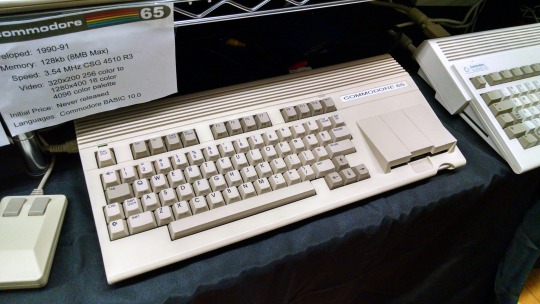
It sits in the pile with the rest of history's pre-production computers that never made it. It's been awhile since I went on a Commodore 65 rant...
The successor to the C64 is the C128, arguably the pinnacle of 8-bit computers. It has 3 modes: native C128 mode with 2MHz 8502, backwards compatible C64 mode, and CP/M mode using a 4MHz Z80. Dual video output in 40-column mode with sprites plus a second output in 80-column mode. Feature-rich BASIC, built in ROM monitor, numpad, 128K of RAM, and of course a SID chip. For 1985, it was one of the last hurrahs of 8-bit computing that wasn't meant to be a budget/bargain bin option.
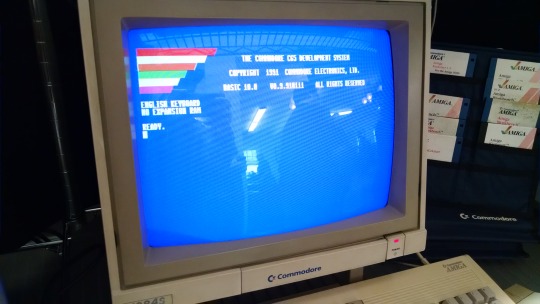
For the Amiga was taking center stage at Commodore -- the 16-bit age is here! And its initial market performance wasn't great, they were having a hard time selling its advanced capabilities. The Amiga platform took time to really build up momentum square in the face of the rising dominance of the IBM PC compatible. And the Amiga lost (don't tell the hardcore Amiga fanboys, they're still in denial).
However, before Commodore went bankrupt in '94, someone planned and designed another successor to the C64. It was supposed to be backwards compatible with C64, while also evolving on that lineage, moving to a CSG 4510 R3 at 3.54MHz (a fancy CMOS 6502 variant based on a subprocessor out of an Amiga serial port card). 128K of RAM (again) supposedly expandable to 1MB, 256X more colors, higher resolution, integrated 3½" floppy not unlike the 1581. Bitplane modes, DAT modes, Blitter modes -- all stuff that at one time was a big deal for rapid graphics operations, but nothing that an Amiga couldn't already do (if you're a C65 expert who isn't mad at me yet, feel free to correct me here).
The problem is that nobody wanted this.
Sure, Apple had released the IIgs in 1986, but that had both the backwards compatibility of an Apple II and a 16-bit 65C816 processor -- not some half-baked 6502 on gas station pills. Plus, by the time the C65 was in heavy development it was 1991. Way too late for the rapidly evolving landscape of the consumer computer market. It would be cancelled later that same year.
I realize that Commodore was also still selling the C64 well into 1994 when they closed up shop, but that was more of a desperation measure to keep cash flowing, even if it was way behind the curve by that point (remember, when the C64 was new it was a powerful, affordable machine for 1982). It was free money on an established product that was cheap to make, whereas the C65 would have been this new and expensive machine to produce and sell that would have been obsolete from the first day it hit store shelves. Never mind the dismal state of Commodore's marketing team post-Tramiel.

Internally, the guy working on the C65 was someone off in the corner who didn't work well with others while 3rd generation Amiga development was underway. The other engineers didn't have much faith in the idea.
The C65 has acquired a hype of "the machine that totally would have saved Commodore, guise!!!!1!11!!!111" -- saved nothing. If you want better what-if's from Commodore, you need to look to the C900 series UNIX machine, or the CLCD. Unlike those machines which only have a handful of surviving examples (like 3 or 4 CLCDs?), the C65 had several hundred, possibly as many as 2000 pre-production units made and sent out to software development houses. However many got out there, no software appears to have surfaced, and only a handful of complete examples of a C65 have entered the hands of collectors. Meaning if you have one, it's probably buggy and you have no software to run on it. Thus, what experience are you recapturing? Vaporware?
The myth of the C65 and what could have been persists nonetheless. I'm aware of 3 modern projects that have tried to take the throne from the Commodore 64, doing many things that sound similar to the Commodore 65.
The Foenix Retro Systems F256K:

The 8-Bit Guy's Commander X16
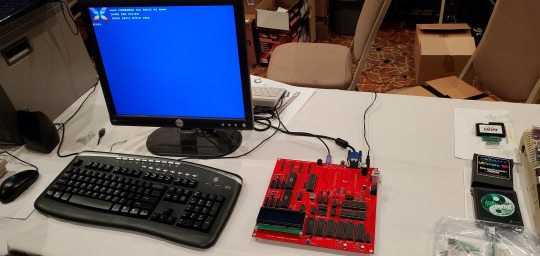
The MEGA65 (not my picture)
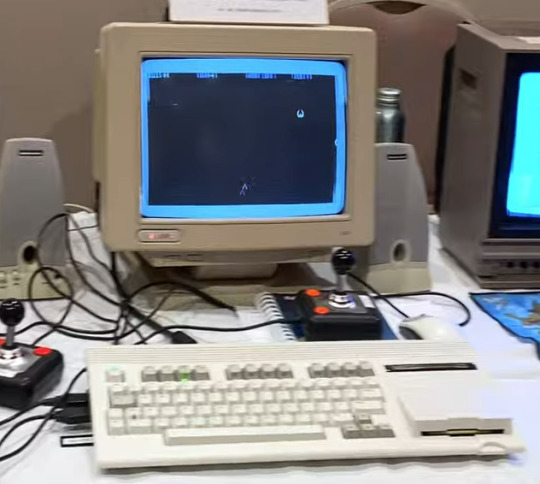
The last of which is an incredibly faithful open-source visual copy of the C65, where as the other projects are one-off's by dedicated individuals (and when referring to the X16, I don't mean David Murray as he's not the one doing the major design work).
I don't mean to belittle the effort people have put forth into such complicated projects, it's just not what I would have built. In 2019, I had the opportunity to meet the 8-Bit Guy and see the early X16 prototype. I didn't really see the appeal, and neither did David see the appeal of my homebrew, the Cactus.
Build your own computer, build a replica computer. I encourage you to build what you want, it can be a rewarding experience. Just remember that the C65 was probably never going to dig Commodore out of the financial hole they had dug for themselves.
262 notes
·
View notes
Text
1962 Plymouth Savoy Max Wedge: Unleashing the Power of Muscle

1962 Plymouth Savoy Max Wedge
In 1962, a new era of muscle cars emerged, radiating brilliance and power. Chrysler led the way with their groundbreaking Max Wedge lineup, introducing the world to the fusion of unitized-body construction and the high-performance ram-tuned dual-carbureted 413 CI engine. Among these legends was the Plymouth Savoy Max Wedge, a remarkable vehicle that holds a significant place in automotive history.

1962 Plymouth Savoy Max Wedge

1962 Plymouth Savoy Max Wedge
The First Super Stock Max Wedge with Manual Transmission According to the esteemed Chrysler Registry and the meticulous documentation by Darrell Davis, this specific Plymouth Savoy Max Wedge holds a groundbreaking distinction—it was the first Super Stock model equipped with a manual transmission. The car’s odometer displays a mere 6,593 miles and has undergone a meticulous restoration process to return it to its original specifications. Notably, the engine has been upgraded, boasting a dyno-proven power output exceeding 500 HP.

1962 Plymouth Savoy Max Wedge
Unleashing the Power of the 413 CI V-8 Engine The 1962 Plymouth Savoy Max Wedge was powered by the formidable 413 CI V-8 engine. This was the first iteration of Chrysler’s renowned ram induction system, featuring a cross-ram intake manifold meticulously designed to optimize engine efficiency. The engine’s performance was further enhanced by the utilization of cast-iron header-style manifolds, which were rarely preserved but featured in this exceptional vehicle. Dale Reed of California refreshed the engine around 300 miles ago, ensuring its optimal performance. The correct Carter AFB carburetors reside beneath dual black air cleaners, accentuated by carefully placed decals.

1962 Plymouth Savoy Max Wedge

1962 Plymouth Savoy Max Wedge
A Unique Manual Transmission Experience One of the distinctive aspects of this Plymouth Savoy Max Wedge is its manual transmission. Unlike its automatic counterparts, this car delivers a unique driving experience through its floor-mounted shifter, allowing the driver to truly feel the power at their fingertips. Paired with a full aftermarket exhaust equipped with cutouts and the robust 8 ¾ Chrysler differential, this Max Wedge offers an exhilarating ride for those who crave the thrill of the open road.

1962 Plymouth Savoy Max Wedge
Captivating Style and Authenticity The exterior of this Plymouth Savoy Max Wedge embodies the spirit of the era. Finished in captivating light blue paint, it exudes a timeless charm. The interior features a complementary blue cloth-and-vinyl combination, while the white-and-blue two-tone trim adds an elegant touch. The front and rear bench seats provide comfort, and the radio delete plate pays homage to the car’s performance-focused nature. Notably, it features a knee-knocker S-W column-mounted tachometer and a beautifully presented trio of rubber pedals. The car’s attention to detail is evident throughout, with the inclusion of circa-1962 chrome fonts, single-lens tail lamps, and OEM steel wheels adorned with poverty-type hubcaps.

1962 Plymouth Savoy Max Wedge

1962 Plymouth Savoy Max Wedge
Provenance and Documentation Accompanying this Plymouth Savoy Max Wedge is a wealth of provenance and documentation that adds to its allure. It includes the original OEM IBM punch card and build sheet, which serve as a testament to its authenticity. Additionally, the window sticker provides insight into its original specifications, while the dyno sheet confirms its impressive horsepower rating. Vintage photos capture the car’s early years when it was part of a famous drag car collection, showcasing its illustrious past.

1962 Plymouth Savoy Max Wedge

1962 Plymouth Savoy Max Wedge
Conclusion The 1962 Plymouth Savoy Max Wedge stands as a testament to the golden age of muscle cars. With its groundbreaking manual transmission configuration, powerful 413 CI V-8 engine, and captivating style, it represents the pinnacle of Mopar’s storied performance heritage. Meticulously restored to its original glory, this Max Wedge allows enthusiasts to experience a bygone era’s raw power and timeless charm.
FAQs: How many miles does the 1962 Plymouth Savoy Max Wedge have? The odometer of the 1962 Plymouth Savoy Max Wedge reads 6,593 miles. Who documented the Chrysler Registry for this particular car? The meticulous documentation of the Chrysler Registry for this car was done by Darrell Davis. Has the engine of the 1962 Plymouth Savoy Max Wedge been upgraded? Yes, the engine of this Plymouth Savoy Max Wedge has been upgraded to a dyno-proven 500-plus HP. What is the significance of the 413 CI V-8 engine in this car? The 413 CI V-8 engine in this car was the first to receive Chrysler’s shortened version of ram induction, known as the cross-ram intake. It maximizes engine efficiency and pairs it with rarely preserved cast-iron header-style manifolds. What documentation and provenance come with this Plymouth Savoy Max Wedge? This Plymouth Savoy Max Wedge comes with various documentation, including the OEM IBM punch card, build sheet, window sticker, dyno sheet confirming horsepower rating, and vintage photos of its early years as part of a famous drag car collection.
#Plymouth Savoy Max Wedge#Plymouth Savoy#plymouth#Max Wedge#car#cars#muscle car#american muscle#mopar#moparperformance#moparnation#moparworld
95 notes
·
View notes
Text

The first place that “do not fold, spindle or mutilate” was taken off the punch card and unpacked in all its metaphorical glory was the student protests at the University of California-Berkeley in the mid-1960s, what became known as the “Free Speech Movement.” The University of California administration used punch cards for class registration. Berkeley protestors used punch cards as a metaphor, both as a symbol of the “system” — first the registration system and then bureaucratic systems more generally — and as a symbol of alienation.
[…]
Because the punch card symbolically represented the power of the university, it made a suitable point of attack. Some students used the punch cards in subversive ways. An underground newspaper reported:
Some ingenious people (where did they get this arcane knowledge? Isn’t this part of the Mysteries belonging to Administration?) got hold of a number of blank IBM cards, and gimmicked the card-puncher till it spoke no mechanical language, but with its little slots wrote on the cards simple letters: “FSM”, “STRIKE” and so on. A symbol, maybe: the rebels are better at making the machine talk sense than its owners. (“Letter from Berkeley” 12; Draper 113)
Students wore these punch cards like name tags. They were thought sufficiently important symbols of the Free Speech Movement that they were used as illustrations on the album cover of the record that the Movement issued.
Another form of technological subversion was for students to punch their own cards, and slip them in along with the official ones: Some joker among the campus eggheads fed a string of obscenities into one of Cal’s biggest and best computers — with the result that the lists of new students in various classes just can NOT be read in mixed company. (Berlandt, “IBM Enrolls” 1)
These pranks were the subversion of the technician. The students were indicating their ability to control the machines, and thus, symbolically, the machinery of the university. But it also indicates, like the students’ and administrations’ shared use of the machine metaphor, something of the degree of convergence of student and administration beliefs and methods. This sort of metaphorical technical subversion rarely rises above the level of prank.
Perhaps more radical, or at least with less confused symbolism, were students who destroyed punch cards in symbolic protest: the punch cards that the university used for class registration stood for all that was wrong with the university, and by extension, America. Students at Berkeley and other University of California branches burned their registration punch cards in anti-University protests just as they burned draft cards in anti-Vietnam protests.
—Steven Lubar, “Do Not Fold, Spindle or Mutilate”: A Cultural History of the Punch Card
29 notes
·
View notes
Text
The story of Microsoft's meteoric rise and IBM's fall has been on my mind lately. Not really related to any film, but I do think we're overdue for an updated Pirates of Silicon Valley biopic. I really think that the 80's and 90's had some wild stories in computing.
If you ask the average person what operating system your computer could have they'd say that if it's a PC it has Windows, and if it's a Mac it has macOS. All home computers are Macs or PCs, but how did it get this way?
In the 70's everyone was making home computers. Tandy was a leather supply goods company established in 1919, but they made computers. Montgomery Ward was a retail chain that decided to make their own store brand computers. Commodore, Atari, NEC, Philips, Bally and a million other assorted companies were selling computers. They generally couldn't talk to each other (if you had software for your Tandy it wouldn't work on your Commodore) and there was no clear market winner. The big three though were Tandy (yeah the leather company made some great computers in 78), Commodore and Apple.
IBM was the biggest computer company of all, in fact just the biggest company period. In 1980 they had a market cap of 128 billion dollars (adjusted for inflation). None of these other companies came close, but IBM's success was built off of mainframes. 70% of all computers sold worldwide were IBM computers, but 0% of it was from the home market.
IBM wanted to get into this growing and lucrative business, and came up with a unique plan. A cheap computer made with commodity parts (i.e. not cutting edge) that had open architecture. The plan was that you could buy an IBM Personal Computer (TM) and then upgrade it as you please. They even published documentation to make it easy to build add ons.
The hope was that people would be attracted to the low prices, the options for upgrades would work for power users, and a secondary market of add ons would be created. If some 3rd party company creates the best graphics card of all time, well you'd still need to buy an IBM PC to install it on.
IBM was not in the home software business, so they went to Microsoft. Microsoft produced MS-DOS (based on 86-DOS, which they licensed) but did not enforce exclusivity. That meant that Microsoft could sell MS-DOS for any of their competitors too. This was fine because of how fractured the market was. Remember, there were a lot of competitors, no one system dominated and none of the competitors could share software. Porting MS-DOS to every computer would have taken years, and by that point it would be outdated anyways.
IBM saw two paths forward. If the IBM PC did well they would make a ton of money. Third party devs like Microsoft would also make a lot of money, but not as much as IBM. If it failed, well then no one was making money. Either way the balance of power wouldn't change. IBM would still be at the top.
IBM however did not enjoy massive profits. It turns out that having cheap components and an open architecture where you could replace anything would... let you replace anything. A company like Compaq could just buy their own RAM, motherboards, cases, hard drives, etc. and make their own knockoff. It was easy, it was popular, and it was completely legal! Some people could order parts and build their own computer from scratch. If you've ever wondered why you can build your own computer but not your own tv or toaster, this is why. IBM had accidentally created a de facto standard that they had no control over.
In 1981 IBM's PC was worth 2.5% of the marketshare. By 1995 IBM PC compatibles were 95% of the marketshare, selling over 45 million units and IBM had to share the profits with every competitor. Apple is the only survivor of this time because the Macintosh was such an incredible piece of technology, but that's a different story for a different time.
And Microsoft? Well building an OS is much harder than putting together a few hardware components, so everyone just bought MS-DOS. With no exclusivity agreement this was also legal. That huge marketshare was now the basis for Microsoft's dominance.
IBM created a computer standard and gave the blueprints to every competitor and created a monopoly for Microsoft to boot. And that's why every computer you buy either is made by Apple with Apple software, or made by anyone else with Microsoft software. IBM is back where they started, having left the home computer business in 2005.
It's easily the biggest blunder in computer history. Other blunders have killed companies but none were quite as impactful as this one.
This story, and many others I know of, I first read in "In Search of Stupidity", a book authored by a former programmer and product manager that was able to see a lot of this first hand. I make no money advertising this book, I just had a great time reading it.
#software#hardware#microsoft#ibm#apple#tandy#nec#compaq#Wordstar#borland#ashton-tate#lotus#Ms-dos#windows#word#excel#access#commodore#atari#philips#bally#In search of stupidity#macintosh#montgomery ward#pirates of silicon valley
10 notes
·
View notes
Text



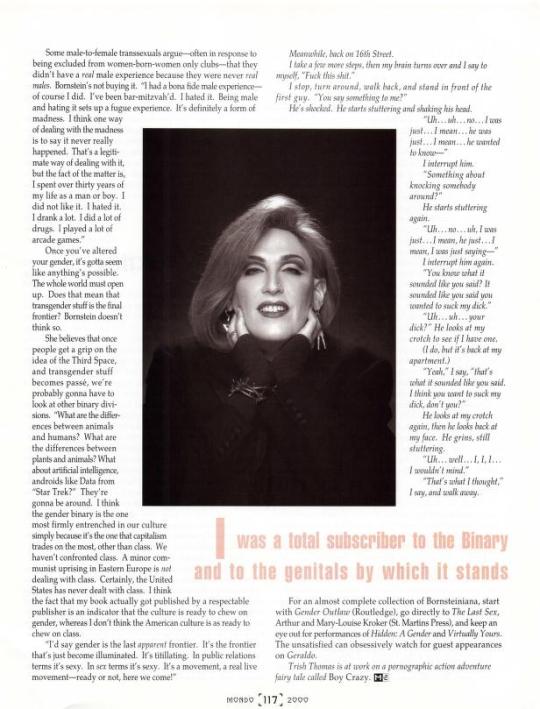
Interview with nonbinary trans author Kate Bornstein, promoting her book Gender Outlaw (Mondo 2000 #13, 1995)
Full text under cut
I‘m walking down 16th Street minding my own business. This good looking woman is coming toward me. She's got on baggy unbuttoned overalls and an orange tank top. Her arms look good, her shoulders look good, and what I can see of her stomach looks good. Two guys are standing on the sidewalk. As she passes them, one says to the other, “I'd like to take that one home.” The other guy agrees. The woman keeps walking. Now it's my turn to pass 'em. “I'd like to take that one home and knock A her around a little bit,” the first guy says. I keep walking. The other guy answers. “That's a her?”
But enough about me. This is supposed to be about Kate Bornstein who wants you to read her new book Gender Outlaw. Bornstein used to be a man; now she’s not. Bornstein used to be a heterosexual; now she isn't. Bornstein used to have a dick; now she doesn’t.
She’s a “used-to-be-a-man, three husbands, father, first mate on an ocean-going yacht, minister, high-powered IBM sales type, Pierre Cardin three-piece suitor, bar-mitzvah’d, circumcised yuppie from the East Coast… a used-to-be politically correct, wanna-be butch, dyke phone sex hostess, smooth talking, telemarketing, love slave, art slut, pagan Tarot reader, maybe soon a grandmother, crystal palming, incense burning, not man, not always a woman, fast becoming a Marxist.”
All that’s not what makes her an outlaw. What makes her an outlaw is she sees a time when folks will look at the binary gender system and throw back their heads and laugh— ha ha ha. Males and females and that’s it? Ha ha ha. Get the fuck outta here.
Bornstein’s looking forward to us all living in what author Marjorie Garber (Vested Interests, Routledge) calls the Third Space. “This whole concept of three is so beautiful,” Kate says, “because it includes the first two. I don’t say there’s a third space that exists between men and women. I say there’s a third space outside of the Binary which leaves the Binary as this construct off to the side, very fragile and apt to fall apart.”
If I were a man, everything about me that brings me grief in the world—the way | walk, the way I talk, the way I think, the way | stand, the way I sit, the way I dress, the way | cut my hair, how much I weigh, how much weight I lift—would not only be acceptable, it would be revered. If we lived in the Third Space, it wouldn't even matter.
Bornstein had to learn a lot of rules in order to fit in. Like when a man walks down the street he looks people in the eye; when a woman walks down the street she looks at the ground. And women talk different. They have higher, breathier voices and their speech is more modulated. In mixed conversations, it’s the woman's job to laugh at the bad jokes and fill in the awkward silences. They smile constantly while they’re talking and use tag questions to qualify sentences, like “you know what I mean?”
“All of these customs are forms of self-deprecation,” says Bornstein, “like learning how to keep my knees together and not putting my arm across the back of my seat in the subway train. A lot of that was not so much to be a woman as to pass as a woman, so that I wouldn't call attention to myself.”
If we lived in the Third Space, she wouldn't have had to worry. In fact, if we lived in the Third Space, she might not even have had penile conversion surgery.
“I don’t do well with might-have-beens,” she says. “I resent that I was manipulated into that surgery by every signpost in the culture. I was not aware of other possibilities at the time. I was a total subscriber to the Binary and to the genitals by which it stands.
“I knew I wasn’t BOY, I knew I wasn’t MAN. Neither of those categories fit for me. It didn’t feel right, I have no idea why. I tried for thirty some odd years and it didn’t work. The only other option I saw in the culture was GIRL, or WOMAN. Nowhere did I see that it was okay to be a “real woman”—which I believed in—with a penis! So the next step was get rid of the penis. This insistence on the Binary and the genital imperative that signals the Binary coerced me into that. If I knew everything that I know now, would I do it again? Yes. Absolutely yes, because sex is so much more fun now.”
Back to this idea of the Third Space, how do we get there?
“Cyberspace would be a doorway into the Third Space,” according to Bornstein. “Cyberspace frees us up from the restrictions placed on identity by our bodies. It allows us to explore more kinds of relationships.
“I can go online as anything. I go online as various kinds of women. I've gone online as a guy a couple of times; I’m playing a stable boy in a vampire scenario now. I’ve gone online as different monsters. I’ve gone online as Mr. Spock in a ‘Star Trek’ scenario.
“Cross-gender identity surfing online is so telling: Men slum and women step into the trappings of power as men. You talk to a man after he’s been a woman online and he'll usually laugh and describe some kind of sex he had, usually lesbian sex. But you talk to a woman who's been surfing as a man, there’s this spark there. There’s this wonder. There's this—'They really do have this power!’ As soon as men cop to the idea that women are learning this, they’re gonna be more frightened.”
Bingo.
In Gender Outlaw, Bornstein asks: “If wealth and power are important, and if in this world wealth and power belong to men, then why did I cease being a man and give up that wealth and power?"
Some male-to-female transsexuals argue—often in response to being excluded from women-born-women only clubs—that they didn’t have a real male experience because they were never real males. Bornstein’s not buying it. “I had a bona fide male experience—of course I did. I’ve been bar-mitzvah’d. I hated it. Being male and hating it sets up a fugue experience. It’s definitely a form of madness. | think one way of dealing with the madness is to say it never really happened. That’s a legitimate way of dealing with it, but the fact of the matter is, I spent over thirty years of my life as a man or boy. I did not like it. I hated it. I drank a lot. I did a lot of drugs. I played a lot of arcade games.”
Once you've altered your gender, it’s gotta seem like anything’s possible. The whole world must open up. Does that mean that transgender stuff is the final frontier? Bornstein doesn’t think so.
She believes that once people get a grip on the idea of the Third Space, and transgender stuff becomes passé, we're probably gonna have to look at other binary divisions. “What are the differences between animals and humans? What are the differences between plants and animals? What about artificial intelligence, androids like Data from “Star Trek?” They're gonna be around. | think the gender binary is the one most firmly entrenched in our culture simply because it’s the one that capitalism trades on the most, other than class. We haven't confronted class. A minor communist uprising in Eastern Europe is not dealing with class. Certainly, the United States has never dealt with class. I think the fact that my book actually got published by a respectable publisher is an indicator that the culture is ready to chew on gender, whereas I don’t think the American culture is as ready to chew on class.
“I'd say gender is the last apparent frontier. It’s the frontier that’s just become illuminated. It’s titillating. In public relations terms it’s sexy. In sex terms it’s sexy. It’s a movement, a real live movement—ready or not, here we come!”
Meanwhile, back on 16th Street.
I take a few more steps, then my brain turns over and I say to myself, “Fuck this shit.”
I stop, turn around, walk back, and stand in front of the first guy. “You say something to me?”
He’s shocked. He starts stuttering and shaking his head.
“Uh…uh…no…I was just…I mean…he was just…I mean…he wanted to know—"
I interrupt him.
“Something about knocking somebody around?”
He starts stuttering again.
“Uh…no…uh, I was just… I mean, he just… I mean, I was just saying—"
I interrupt him again.
“You know what it sounded like you said? It sounded like you said you wanted to suck my dick.”
“Uh…uh… your dick?” He looks at my crotch to see if I have one.
(I do, but it’s back at my apartment.)
“Yeah,” I say, “that’s what it sounded like you said. I think you want to suck my dick, don't you?”
He looks at my crotch again, then he looks back at my face. He grins, still stuttering.
Uh...well...I, I, I... I wouldn't mind.”
“That's what I thought,” I say, and walk away.
For an almost complete collection of Bornsteiniana, start with Gender Outlaw (Routledge), go directly to The Last Sex, Arthur and Mary-Louise Kroker (St. Martins Press), and keep an eye out for performances of Hidden: A Gender and Virtually Yours. The unsatisfied can obsessively watch for guest appearances on Geraldo.
#was looking at old cyberpunk magazines and this one just happened to have an interview with bornstein in it what a treat 😊#warning for some dated editorializing as you can imagine but its still cool to see where gender politics were three decades ago#kate bornstein#gender outlaw#mondo 2000#///
42 notes
·
View notes
Text
The Future of The Internet: An Intuitive Deep Dive Into The Madness Of Millions
First off: This is gonna be a prediction on such a mass scale. I don't expect anyone to really FULLY pick this up (it is a prediction after all, so it's like throwing stuff at the wall to see what sticks). But from what my spirit guides are telling me to do right now, they want me to push this out as far as I can because of the Pluto In Aquarius permanent ingress happens next year. We're all changing for the better and somehow the internet is going to FULLY reflect that. Why am I capitalizing 'fully'? Three of the most mundane planets are influencing this. Uranus, Neptune and Pluto. The icey planets are changing the paradigm soon and it's gonna flip a whole switch on our digital reality. Kind of like a 'whopping us into some sense' type of way. A rough face slap essentially. Or would it be like a baby giraffe who just arrived and has gotta walk on stubbly legs? Who knows. And because of the current state of hateful and aware affairs.... it looks pretty tribal and yet all too liberating at the same time. Without further ado, more below the cut!! ~ <3
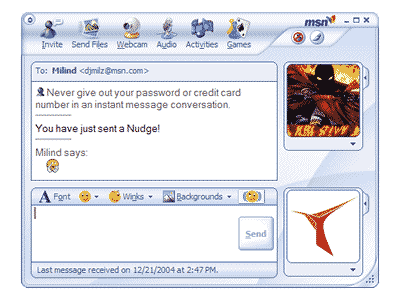
HISTORY
Now most aren't really too speculative on where the internet started, but with a little research on hand, there have been speculations that the original basis for the internet and how it was programmed in it's "alpha" form, would be around October 29th, 1969. It was mainly a military owned and insider personnel type thing. Used for the benefit of the government to send messages to its military at a faster rate than normally possible at that time. Doesn't help that if we keep it to the basics of the sun being in scorpio (the personification of what 'underbelly' means), and knowing the ruler of that sign being Pluto (which so happens to be in a mercurial/communicative sign, Virgo), insider communication seems to check out perfectly. Setting the precedent of what's to come.
On closer inspection Pluto sat at the last decan of Virgo. Taurus being its sub-ruler. Which brings its slow-notoriety and slow-growth to the public eye.
Because after over a decade, the internet has its "beta" release because of Xerox's more interactive systems. Networks being more common, has brought more information sharing and an ultimate release for IBM systems. The computer went from a government owned invention, to a technological advancement for business and relaying data on stock prices on January 1st 1983. Very much a business incorporated sign for it to be born in, being Capricorn, we look to its ruler Saturn for extra conformation. Again, more notions of privacy and economy come to the internet. It sits once more in Scorpio. Dealing with the 'underbelly' once again. Taking another chance to look at the ruler of the sign Saturn was sitting in, it brings us to Pluto being in Libra. Which libra does deal with connections and solid foundations among people. Agreements and liability. Saturn's exalted sign as well, don't forget.
So the two (Saturn and Pluto) are in mutual reception. Businesses and powers-that-be are in symbiosis despite neighboring one another. Neutralization of any discomfort (which makes me think of a sextile -- a sextile that isn't a sextile at all (man, ping that to your notes about mutual reception hehe)).
Then, when 1984 came around, the Macintosh released the FatMac. Bringing the computer to the Homefront with a 'computer for the rest of us'. A bit of virtue signaling to the future of where computers were ULTIMATELY headed. We love Apple. God bless the genius of Steve Jobs y'all <3 (besides we'll do a whole bit on this at some point the more I think on that). But to bring the internet to the Homefront, coding had to have improved. Which, once more and finally, do we get to the internet "driving down your neighborhood street". It finally comes home on April 30th 1993. A nearly exact opposite to the "alpha" release we discussed all the way at the beginning of this section. This is where the 1.0 phase of the internet comes in. The World Wide Web ("www"). From personal studies on dates I thought were significant, colored blue like this, this day would particularly stick out to be a very Saturn and Moon dominant day. Jupiter being in third. It brings a structural (Saturnian) and personal (Lunar) backdrop to what's coming down later. HTML was released this year as well. Bringing more of an emphasis on that structure. Setting off more of the creativity in some people. In terms of modality, it was Cardinal heavy. Pioneering and brand new. Plus, because of the newness to this invention and the fact that this IS the 1.0 release, it started a... settling the Oregon trail kind of energy.
I know, the connotations of saying that are very dark, but an analogy is an analogy. We colonized the digital space as a human race. And we still do with the sphere of the STILL current invention of Virtual Reality.... lil food for thought..
Let's backtrack to the nineties once more shall we? I'm not done (cause we're only getting started!)
Geocities
Established and released in November of 1994, this started the wide WIDE reach to have people start their own website. A lot of the energies involved were once again tied to Scorpio. Now beginning to show the Piscean side on top of that. Tying in more creativity and personal-ness to the sites people had made. Capricorn being involved too, enhancing the structure of the internet once again with the infamous release of this digital product.
To make another very similar analogy to American history, the internet has brought a sense of decentralized-ness. Or, if we were going to use a more 'american-historical' term, it was a 'confederation of sites'. No big central power to the way in which it worked. Even if you had search engines. It was all of the people who made them.
To make an astrological connection to this, Saturn (structure and now coding), was in Aquarius. A sign dedicated to the underdog and smaller man. The 'we-the-people' kind of energy that we see now with Pluto in Aquarius in 2024.
God had blessed the United States back then am I right?
Time flies and now we land on the date December 17th 1996. CSS and coding for the 'look' of a website makes itself a lot more accessible and easier for people to grasp. Better yet, it was a tool released for the folks willing to enhance usability and design for their digital experience at the time.
The energies on that date were relatively splashed. Nothing too significant. And with my synesthesia, the one thing that comes to mind when someone says 'splash' is paint and iridescence. Bringing more of that emphasis on the freedom to design and enhance a users experience in the personality of sites that were created. By 1996 though, Pluto has finally reached Sagittarius! GEN Z REIGN SUPREME (despite our never-ending depression we'll get through it though I promise you that)!! Again, igniting that need to bring a sense of adventure. More people start to join the online space. With Saturn at zero Aries by this day (structures in detriment and a new Saturn cycle sadly), there's a theme of freshness and the slates wiped. So, again, more pioneering and newness. Hell. This is where Saturn and Pluto are in trine with one another. And if the powers-that-be externally meet up in harmony like this, oh you know it's gooooooddd.
The golden age of the internet begins.
Although started with water, invert the alchemical triangle to the upright position..... and alchemy begins to take shape. so to say~
GOLDEN AGE - 1999
Alrighty! We made it to the y2k movement pre-2000s. color was all the rage thanks to CSS and HTML makes it much more possible to code ones own sites. The tools continue to evolve and become more advanced. Not to mention the commodified Windows 95 and 98 experience was well underway this year, and Macintosh brought in Mac OS by this point. I mean... do you see this absolutely gorgeous graphics on both of them????
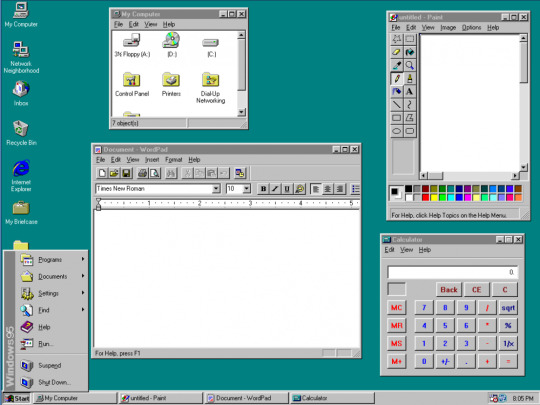
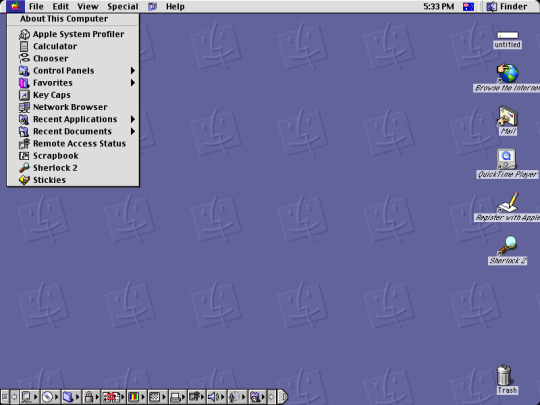
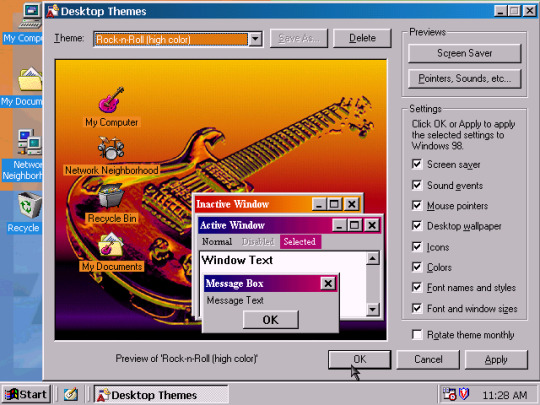
(even though they were rivals, they both had a lovely look to them)
what comes next after these years? 1999 of course! A BIG PROPRIETOR FOR 2.0
Geocities get's acquired by Yahoo! (January 28th 1999): This day was huge with a lot of energies being torn between Taurus and Aquarius (yet, I see the contrasting energies actually quite beneficial to one another). Most of the Taurus comes from the degrees in which some of the planets were situated (using degree theory as a base for this). But the contrast on both has fixed earth and fixed air. Some would say it's because the detached and logical energy of Aquarius doesn't get the slow to grow and traditional ways of life side of Taurus, but I see them coexisting. Like how fog creates the dew in grass on those very revitalizing yet calm 'last days of school' that you may have experienced. Take what resonates as usual. If it doesn't es fine. But it's foggy air, calm winds and the dew sitting on cool crisp grass. It's a good mix. Hell one could say it's Venus and Uranus working together. A wonderful (Venusian) surprise (Uranian) to the collective. Hell it made Geocities far more accessible because of Yahoo being a rising name in the internet search engine space.
HTML 4.01 (December 1999) Maybe it was an attempt to absolve the 'y2k' bug, maybe it wasn't. But what it DID bring, was more unanimity to the eventual structure of the internet. The Taurus-Aquarius energies are still prominent, yet it was slightly different with Jupiter at 25º of Aries. Doubling up on Aries energy since 25º Aries is on an Ariean degree. So, more luck in pioneering more sites for more online adventures. Saturn in particular was in 11º Taurus (in the Aquarian degree) when the released occured this month. Bringing more of that 'stability' aspect to the freedom to code. And then the outer planets were set in Aquarius to Taurus degrees. Except for Pluto..... Sagittarius 10º.... Capricorn degree. This was gonna lead to success either way.
2000's
So, what else? We made it to 2000. And 2.0 was at its time. It brought such big risers like YouTube, Facebook and MySpace this decade. Geocities continues to be used and with that, there was more of an emphasis on respect for what people brought to the online space.
It of course raised the question about living double lives and with the invention of proto-social media, personas slowly begin to fall. Eventually there's more real-life integration and an 'everyone in' type energy because of Pluto in Sagittarius destroyed the boundaries of intercontinental travel with the advent of speaking to someone on the other side of the planet with your PC. Fucking wild shit man.
Soon, the 2010's approach. Windows 8 is soon to release in the next few years
.... it brings us to another component.
2013 - Neocities
The indie web. An alternative to Geocities because it used HTML4.whatever at this point. Evolution is pretty hard to pay attention to when you're tryin' to write a whole thing on the history of how we function on the web; just to prove a point.
Before we go on about the astrology of such, this year also marks a turning point in the internet. I personally see this as the seed for delusion and craze. Social media starts to make our real life selves more noticeable. Sure, it enhanced communication to an even MORE personal level. But, the internet was highly synthetic and had fictional tones. So, the homogenization begins with bringing those same sites who were rising stars in the 2.0 era, into the current state of affairs. They became big conglomerates. Years continue with them starting to implement ad-revenue systems, stock exchange and other such money-power-lucrative systems that the newly ingressed Pluto in Capricorn is willing to expose. By 2019, geocities is completely shut down. Personality has been swiped away in trade of Wix's dull and corporate look.
Back to my point, a secret stem to this internet begins to slowly form. Neocities.
June 28th 2013
Because this site is a major nostalgia revamp, its ultimate goal of replicating and replacing the former private-on-public-server brethren has since reached its goal today. Look to Tumblr and you notice the culture if you throw in the hashtag for it. Most people don't notice since they're too busy protesting thanks to Neptune in Pisces being our current cycle. Yet, when you want to leave the homogenized internet for something a little more personal and free to your own designs, then this would be your ticket. But it's gonna take effort to code a site.
Much like it takes effort to build a home, this release has a slight pull toward more of a water dominant presence. Bringing the full story of privacy and personality full front and center. But, because of the addition of fire in its chart, there's a lot of support for the freedom to adventure out and stand out. So, Fire and Water heavy.
It's best to work in short bursts. But put your ALL into it when you can/do.
NOW
With the advent of Neptune in Aries, Uranus in Gemini, and Pluto in Aquarius being on the precipice of what's to come, I think there'd be point where the homogenization of the internet is going to be too much to bear. I'm not trying to make this an eventual doomscroll, but don't you feel like the internet is kinda..... dying? Do we really need AI? Do we really need Bitcoin? Do we reallyyyy need this or that or anything to digitally exist other than just a little taste of our souls? I see a split (fracture) and a break.
SPLIT
if push comes to shove and we DON'T regulate AI or make it so where it's NOT subscribe able and it's a free service (i.e. we teach people the ways of building these mechanisms and make it easier to do so), then the internet is gonna split.
You'll have social media (the first one in the group), suddenly fall. The toxic nature could start to die down and become less and less significant as we get around to moderating our use. Respect could come back this way, but with the advent of that, it's the responsibility that comes with using the internet. Being careful with what you put out and more needs to teach digital literacy at a younger audience.
Fandom could take a slight hit because of this. Having a full-circle experience of everything I had to know about what it means to be in one, from being banned, blocked to accepted and loved, as well as the arguments over logistical means in a fictional world (which by the way Neptune in Pisces loves to blend reality with the incomprehensible imagination and raw emotions we get). Antiship and Proship wars too. (That's also gonna be something I wish to talk about with my Neptune in Aries predictions) But because of the 'digital literacy' clause and intent of stuff stated above, it'll take a slight hit where fandom may have a more respectful way of saying or doing such and so. Silent blocks, DNI alerts, the usual that we're so encompassed to.
Other than that: Forums or modified forums become the norm as we revert to a more personal and open lifestyle with the digital space. Doxxing and callouts will still happen, yet I feel as a greater disdain and utter repulsion for it could occur. All of this could be known as ADAPTATION for some. Better yet, true RESPECT.
BREAK
If push comes to shove and the internet space begins to get a little too dicey and personal, basically making it more of that TRIBAL sense of finding your people (not to mention it starts to also devolve to where there's cases of subconscious levels of aggression and too many 'what-if's' being thrown around -- i.e. assumptions, accusations and subliminal hate), then something out there or somewhere is gonna completely tear apart the fabric of the internet. For a bleak example: a foreign country hacks into our digital region. Our VPN.
Aries is ruled by Mars. Mars rules knives and seperations. Wars. If Neptune rules over the subconscious over everyone, this could bring about primal actions on a structure like this.
! not to mention that Saturn (code, structure), conjuncts with Neptune (dissolution and dissolving/illusions and spiritual destiny)... and Aries is known for the anger and drive that it has......
we could revert back to a 1.0 like state of mind. Addictions to social media will have huge withdrawals. Attention and clout chasing will get worse outside of that, and it just straight up becomes a crime.
One thing's for certain. We learn a lesson of being careful to not put our personal information out there. .... but that break gives a chance for the proto-web to come back. Hyper-personalization and drive to keep it within chat services like Discord could become even more so the norm or remain as they are. HTML 6 could come out and bringing the retro look with offline capabilities to the public. So as long as we're careful not to once again put our information out there, then that might bring us to once again let the people shine. The key theme with the break is RESTART.
I apologize if it did seem bleak or aggressive. It’s what I channeled and like I said, if you don’t resonate with it, don’t have to worry about it. 🧘✨ my last couple of statements before we close this off with resources, and one is gonna sound a lot like Smokey The Bear.
Care will prevent the destruction of our exchange in ideas and communication. Only YOU can prevent the 'break'. so let's strive for a 'split' alright? ~visiblenostalgia
and then there's something one of my professors had admitted.
"We have more information than ever, but we're more uninformed than ever."
and a small song before I really tie this up.
youtube
love you guys <3
RESCOURCES:
#astrology#astrology observations#pluto in aquarius#aries#astro notes#spotify#astro observations#horoscope#astro community#neptune in aries#history of the internet#neptune in aquarius#neptune in pisces#00s#90s#geocities#neocities#fandom#uranus in gemini#peace and love#embody peace#get peace#respect and be respected back <3#age of aquarius
39 notes
·
View notes
Note
Hello. So what's the deal with computer chips? Let's say, for example, that I wanted to build a brand new Sega Genesis. Ignoring firmware and software, what's stopping me from dissecting their proprietary chips and reverse-engineering them to make new ones? It's just electric connections and such inside, isn't it? If I match the pin ins and outs, shouldn't it be easy? So why don't people do it?
The answer is that people totally used to do this, there's several examples of chips being cloned and used to build compatible third-party hardware, the most famous two examples being famiclones/NESclones and Intel 808X clones.
AMD is now a major processor manufacturer, but they took off in the 70's by reverse-engineering Intel's 8080 processor. Eventually they were called in to officially produce additional 8086 chips under license to meet burgeoning demand for IBM PC's, but that was almost a decade later if I remember correctly.
There were a ton of other 808X clones, like the Soviet-made pin-compatible K1810VM86. Almost anyone with a chip fab was cloning Intel chips back in the 80's, a lot of it was in the grey area of reverse engineering the chips.

Companies kept cloning Intel processors well into the 386 days, but eventually the processors got too complicated to easily clone, and so only companies who licensed designs could make them, slowly reducing the field down to Intel, AMD, and Via, who still exist! Via's CPU division currently works on the Zhaoxin x86_64 processors as part of the ongoing attempts to homebrew a Chinese-only x86 processor.
I wrote about NES clones a while ago, in less detail, so here's that if you want to read it:
Early famiclones worked by essentially reverse-engineering or otherwise cloning the individual chips inside an NES/famicom, and just reconstructing a compatible device from there. Those usually lacked any of the DRM lockout chips built into the original NES, and were often very deeply strange, with integrated clones of official peripherals like the keyboard and mouse simply hardwired directly into the system.
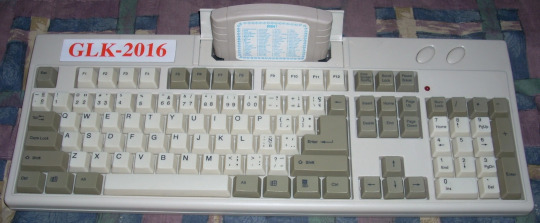
These were sold all over the world, but mostly in developing economies or behind the Iron Curtain where official Nintendo stuff was harder to find. I had a Golden China brand Famiclone growing up, which was a common famiclone brand around South Africa.
Eventually the cost of chip fabbing came down and all those individual chips from the NES were crammed onto one cheap piece of silicon and mass produced for pennies each, the NES-on-a-chip. With this you could turn anything into an NES, and now you could buy a handheld console that ran pirated NES game for twenty dollars in a corner store. In 2002. Lots of edutainment mini-PC's for children were powered by these, although now those are losing out to Linux (and now Android) powered tablets a la Leapfrog.
Nintendo's patents on their hardware designs expired throughout the early 2000's and so now the hardware design was legally above board, even if the pirated games weren't. You can still find companies making systems that rely on these NES chips, and there are still software houses specializing in novel NES games.
Why doesn't this really happen anymore? Well, mostly CPU's and their accoutrements are too complicated. Companies still regularly clone their competitors simpler chips all the time, and I actually don't know if Genesis clones exist, it's only a Motorola 68000k, but absolutely no one is cloning a modern Intel or AMD processor.

The die of a Motorola 68000 (1979)
A classic Intel 8080 is basically the kind of chip you learn about in entry level electrical engineering, a box with logic gates that may be complicated, but pretty straightforwardly fetches things from memory, decodes, executes, and stores. A modern processor is a magic pinball machine that does things backwards and out of order if it'll get you even a little speedup, as Mickens puts it in The Slow Winter:
I think that it used to be fun to be a hardware architect. Anything that you invented would be amazing, and the laws of physics were actively trying to help you succeed. Your friend would say, “I wish that we could predict branches more accurately,” and you’d think, “maybe we can leverage three bits of state per branch to implement a simple saturating counter,” and you’d laugh and declare that such a stupid scheme would never work, but then you’d test it and it would be 94% accurate, and the branches would wake up the next morning and read their newspapers and the headlines would say OUR WORLD HAS BEEN SET ON FIRE. You’d give your buddy a high-five and go celebrate at the bar, and then you’d think, “I wonder if we can make branch predictors even more accurate,” and the next day you’d start XOR’ing the branch’s PC address with a shift register containing the branch’s recent branching history, because in those days, you could XOR anything with anything and get something useful, and you test the new branch predictor, and now you’re up to 96% accuracy, and the branches call you on the phone and say OK, WE GET IT, YOU DO NOT LIKE BRANCHES, but the phone call goes to your voicemail because you’re too busy driving the speed boats and wearing the monocles that you purchased after your promotion at work. You go to work hung-over, and you realize that, during a drunken conference call, you told your boss that your processor has 32 registers when it only has 8, but then you realize THAT YOU CAN TOTALLY LIE ABOUT THE NUMBER OF PHYSICAL REGISTERS, and you invent a crazy hardware mapping scheme from virtual registers to physical ones, and at this point, you start seducing the spouses of the compiler team, because it’s pretty clear that compilers are a thing of the past, and the next generation of processors will run English-level pseudocode directly.

Die shot of a Ryzen 5 2600 core complex (2019)
Nowadays to meet performance parity you can't just be pin-compatible and run at the right frequency, you have to really do a ton of internal logical optimization that is extremely opaque to the reverse engineer. As mentioned, Via is making the Zhaoxin stuff, they are licensed, they have access to all the documentation needed to make an x86_64 processor, and their performance is still barely half of what Intel and AMD can do.
Companies still frequently clone each others simpler chips, charge controllers, sensor filters, etc. but the big stuff is just too complicated.
182 notes
·
View notes
Text
Back in an era when computers were the size of a room and only government agencies and large companies could afford to have one, IBM was king of the mainframes. But they had a lineup of several incompatible computers, some intended for scientific uses (the IBM 7090/7094), others were for commercial uses (the IBM 7080 and IBM 7010). IBM wanted to have a single unified architecture so that software could be exchanged between them and customers could upgrade from cheaper, lower powered machines to more higher powered ones.
What came out of it was the IBM System/360 line of mainframes (referring to the concept of "360 degrees" making up a circle) that ended up being the dominant mainframe computer for decades to come, it got cloned by competitors, and its descendants are still being produced to this day.
The IBM System/360 had many features that since then became foundational for modern computing.
An entirely binary number system. While some computers (such as the IBM 7090) used a binary system, others operated exclusively in decimal mode, encoded using binary coded decimals using 4 bits for each digit (such as the IBM 7080 and IBM 7010). Others went a step further and were only capable of storing decimal digits 0 to 9 (like the IBM 7070).
To store textual information, each character was stored in 8 bits, establishing the dominance of 8 bit bytes. Previous systems would typically use 6 bits to store text, and would usually only enable a single case of letters. The IBM 7070 didn't provide access to bits and characters were stored in 2 decimal digits. It was also one of the first machines to support the then new ASCII standard, although notably it provided much better support for IBM's proprietary EBCDIC encodings which came to dominate mainframe computing.
Even though it was a 32-bit system, memory was byte addressed. Previous systems would access memory one word at a time (for the IBM 7090, this was 36 bits per word, for the IBM 7010, this was 10 digits plus a sign), or had variable length words and accessed them through their last digits (IBM 7080 and IBM 7010). The IBM System/360 however accessed 32-bit words as 4 bytes by their lowest address byte.
Two's complement arithmetic. Previous machines (even the binary IBM 7090) would encode numbers as sign/magnitude pairs, so for example -3 would be encoded identically to 3 except for the sign bit. Two's complement encoding, now the standard in modern computers, makes it much easier to handle signed arithmetic, by storing -3 as a large power of 2 minus 3.
69 notes
·
View notes
Text
Microsoft pinky swears that THIS TIME they’ll make security a priority
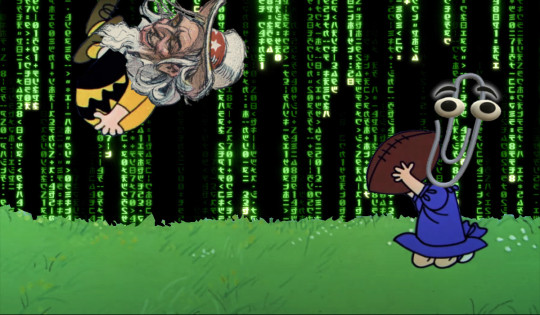
One June 20, I'm live onstage in LOS ANGELES for a recording of the GO FACT YOURSELF podcast. On June 21, I'm doing an ONLINE READING for the LOCUS AWARDS at 16hPT. On June 22, I'll be in OAKLAND, CA for a panel and a keynote at the LOCUS AWARDS.

As the old saying goes, "When someone tells you who they are and you get fooled again, shame on you." That goes double for Microsoft, especially when it comes to security promises.
Microsoft is, was, always has been, and always will be a rotten company. At every turn, throughout their history, they have learned the wrong lessons, over and over again.
That starts from the very earliest days, when the company was still called "Micro-Soft." Young Bill Gates was given a sweetheart deal to supply the operating system for IBM's PC, thanks to his mother's connection. The nepo-baby enlisted his pal, Paul Allen (whom he'd later rip off for billions) and together, they bought someone else's OS (and took credit for creating it – AKA, the "Musk gambit").
Microsoft then proceeded to make a fortune by monopolizing the OS market through illegal, collusive arrangements with the PC clone industry – an industry that only existed because they could source third-party PC ROMs from Phoenix:
https://www.eff.org/deeplinks/2019/08/ibm-pc-compatible-how-adversarial-interoperability-saved-pcs-monopolization
Bill Gates didn't become one of the richest people on earth simply by emerging from a lucky orifice; he also owed his success to vigorous antitrust enforcement. The IBM PC was the company's first major initiative after it was targeted by the DOJ for a 12-year antitrust enforcement action. IBM tapped its vast monopoly profits to fight the DOJ, spending more on outside counsel to fight the DOJ antitrust division than the DOJ spent on all its antitrust lawyers, every year, for 12 years.
IBM's delaying tactic paid off. When Reagan took the White House, he let IBM off the hook. But the company was still seriously scarred by its ordeal, and when the PC project kicked off, the company kept the OS separate from the hardware (one of the DOJ's major issues with IBM's previous behavior was its vertical monopoly on hardware and software). IBM didn't hire Gates and Allen to provide it with DOS because it was incapable of writing a PC operating system: they did it to keep the DOJ from kicking down their door again.
The post-antitrust, gunshy IBM kept delivering dividends for Microsoft. When IBM turned a blind eye to the cloned PC-ROM and allowed companies like Compaq, Dell and Gateway to compete directly with Big Blue, this produced a whole cohort of customers for Microsoft – customers Microsoft could play off on each other, ensuring that every PC sold generated income for Microsoft, creating a wide moat around the OS business that kept other OS vendors out of the market. Why invest in making an OS when every hardware company already had an exclusive arrangement with Microsoft?
The IBM PC story teaches us two things: stronger antitrust enforcement spurs innovation and opens markets for scrappy startups to grow to big, important firms; as do weaker IP protections.
Microsoft learned the opposite: monopolies are wildly profitable; expansive IP protects monopolies; you can violate antitrust laws so long as you have enough monopoly profits rolling in to outspend the government until a Republican bootlicker takes the White House (Microsoft's antitrust ordeal ended after GW Bush stole the 2000 election and dropped the charges against them). Microsoft embodies the idea that you either die a rebel hero or live long enough to become the evil emperor you dethroned.
From the first, Microsoft has pursued three goals:
Get too big to fail;
Get too big to jail;
Get too big to care.
It has succeeded on all three counts. Much of Microsoft's enduring power comes from succeeded IBM as the company that mediocre IT managers can safely buy from without being blamed for the poor quality of Microsoft's products: "Nobody ever got fired for buying Microsoft" is 2024's answer to "Nobody ever got fired for buying IBM."
Microsoft's secret sauce is impunity. The PC companies that bundle Windows with their hardware are held blameless for the glaring defects in Windows. The IT managers who buy company-wide Windows licenses are likewise insulated from the rage of the workers who have to use Windows and other Microsoft products.
Microsoft doesn't have to care if you hate it because, for the most part, it's not selling to you. It's selling to a few decision-makers who can be wined and dined and flattered. And since we all have to use its products, developers have to target its platform if they want to sell us their software.
This rarified position has afforded Microsoft enormous freedom to roll out harebrained "features" that made things briefly attractive for some group of developers it was hoping to tempt into its sticky-trap. Remember when it put a Turing-complete scripting environment into Microsoft Office and unleashed a plague of macro viruses that wiped out years worth of work for entire businesses?
https://web.archive.org/web/20060325224147/http://www3.ca.com/securityadvisor/newsinfo/collateral.aspx?cid=33338
It wasn't just Office; Microsoft's operating systems have harbored festering swamps of godawful defects that were weaponized by trolls, script kiddies, and nation-states:
https://en.wikipedia.org/wiki/EternalBlue
Microsoft blamed everyone except themselves for these defects, claiming that their poor code quality was no worse than others, insisting that the bulging arsenal of Windows-specific malware was the result of being the juiciest target and thus the subject of the most malicious attention.
Even if you take them at their word here, that's still no excuse. Microsoft didn't slip and accidentally become an operating system monopolist. They relentlessly, deliberately, illegally pursued the goal of extinguishing every OS except their own. It's completely foreseeable that this dominance would make their products the subject of continuous attacks.
There's an implicit bargain that every monopolist makes: allow me to dominate my market and I will be a benevolent dictator who spends his windfall profits on maintaining product quality and security. Indeed, if we permit "wasteful competition" to erode the margins of operating system vendors, who will have a surplus sufficient to meet the security investment demands of the digital world?
But monopolists always violate this bargain. When faced with the decision to either invest in quality and security, or hand billions of dollars to their shareholders, they'll always take the latter. Why wouldn't they? Once they have a monopoly, they don't have to worry about losing customers to a competitor, so why invest in customer satisfaction? That's how Google can piss away $80b on a stock buyback and fire 12,000 technical employees at the same time as its flagship search product (with a 90% market-share) is turning into an unusable pile of shit:
https://pluralistic.net/2024/02/21/im-feeling-unlucky/#not-up-to-the-task
Microsoft reneged on this bargain from day one, and they never stopped. When the company moved Office to the cloud, it added an "analytics" suite that lets bosses spy on and stack-rank their employees ("Sorry, fella, Office365 says you're the slowest typist in the company, so you're fired"). Microsoft will also sell you internal data on the Office365 usage of your industry competitors (they'll sell your data to your competitors, too, natch). But most of all, Microsoft harvest, analyzes and sells this data for its own purposes:
https://pluralistic.net/2020/11/25/the-peoples-amazon/#clippys-revenge
Leave aside how creepy, gross and exploitative this is – it's also incredibly reckless. Microsoft is creating a two-way conduit into the majority of the world's businesses that insider threats, security services and hackers can exploit to spy on and wreck Microsoft's customers' business. You don't get more "too big to care" than this.
Or at least, not until now. Microsoft recently announced a product called "Recall" that would record every keystroke, click and screen element, nominally in the name of helping you figure out what you've done and either do it again, or go back and fix it. The problem here is that anyone who gains access to your system – your boss, a spy, a cop, a Microsoft insider, a stalker, an abusive partner or a hacker – now has access to everything, on a platter. Naturally, this system – which Microsoft billed as ultra-secure – was wildly insecure and after a series of blockbuster exploits, the company was forced to hit pause on the rollout:
https://arstechnica.com/gadgets/2024/06/microsoft-delays-data-scraping-recall-feature-again-commits-to-public-beta-test/
For years, Microsoft waged a war on the single most important security practice in software development: transparency. This is the company that branded the GPL Free Software license a "virus" and called open source "a cancer." The company argued that allowing public scrutiny of code would be a disaster because bad guys would spot and weaponize defects.
This is "security through obscurity" and it's an idea that was discredited nearly 500 years ago with the advent of the scientific method. The crux of that method: we are so good at bullshiting ourselves into thinking that our experiment was successful that the only way to make sure we know anything is to tell our enemies what we think we've proved so they can try to tear us down.
Or, as Bruce Schneier puts it: "Anyone can design a security system that you yourself can't think of a way of breaking. That doesn't mean it works, it just means that it works against people stupider than you."
And yet, Microsoft – whose made more widely and consequentially exploited software than anyone else in the history of the human race – claimed that free and open code was insecure, and spent millions on deceptive PR campaigns intended to discredit the scientific method in favor of a kind of software alchemy, in which every coder toils in secret, assuring themselves that drinking mercury is the secret to eternal life.
Access to source code isn't sufficient to make software secure – nothing about access to code guarantees that anyone will review that code and repair its defects. Indeed, there've been some high profile examples of "supply chain attacks" in the free/open source software world:
https://www.securityweek.com/supply-chain-attack-major-linux-distributions-impacted-by-xz-utils-backdoor/
But there's no good argument that this code would have been more secure if it had been harder for the good guys to spot its bugs. When it comes to secure code, transparency is an essential, but it's not a sufficency.
The architects of that campaign are genuinely awful people, and yet they're revered as heroes by Microsoft's current leadership. There's Steve "Linux Is Cancer" Ballmer, star of Propublica's IRS Files, where he is shown to be the king of "tax loss harvesting":
https://pluralistic.net/2023/04/24/tax-loss-harvesting/#mego
And also the most prominent example of the disgusting tax cheats practiced by rich sports-team owners:
https://pluralistic.net/2021/07/08/tuyul-apps/#economic-substance-doctrine
Microsoft may give lip service to open source these days (mostly through buying, stripmining and enclosing Github) but Ballmer's legacy lives on within the company, through its wildly illegal tax-evasion tactics:
https://pluralistic.net/2023/10/13/pour-encoragez-les-autres/#micros-tilde-one
But Ballmer is an angel compared to his boss, Bill Gates, last seen some paragraphs above, stealing the credit for MS DOS from Tim Paterson and billions of dollars from his co-founder Paul Allen. Gates is an odious creep who made billions through corrupt tech industry practices, then used them to wield influence over the world's politics and policy. The Gates Foundation (and Gates personally) invented vaccine apartheid, helped kill access to AIDS vaccines in Sub-Saharan Africa, then repeated the trick to keep covid vaccines out of reach of the Global South:
https://pluralistic.net/2021/04/13/public-interest-pharma/#gates-foundation
The Gates Foundation wants us to think of it as malaria-fighting heroes, but they're also the leaders of the war against public education, and have been key to the replacement of public schools with charter schools, where the poorest kids in America serve as experimental subjects for the failed pet theories of billionaire dilettantes:
https://www.ineteconomics.org/perspectives/blog/millionaire-driven-education-reform-has-failed-heres-what-works
(On a personal level, Gates is also a serial sexual abuser who harassed multiple subordinates into having sexual affairs with him:)
https://www.nytimes.com/2022/01/13/technology/microsoft-sexual-harassment-policy-review.html
The management culture of Microsoft started rotten and never improved. It's a company with corruption and monopoly in its blood, a firm that would always rather build market power to insulate itself from the consequences of making defective products than actually make good products. This is true of every division, from cloud computing:
https://pluralistic.net/2022/09/28/other-peoples-computers/#clouded-over
To gaming:
https://pluralistic.net/2023/04/27/convicted-monopolist/#microsquish
No one should ever trust Microsoft to do anything that benefits anyone except Microsoft. One of the low points in the otherwise wonderful surge of tech worker labor organizing was when the Communications Workers of America endorsed Microsoft's acquisition of Activision because Microsoft promised not to union-bust Activision employees. They lied:
https://80.lv/articles/qa-workers-contracted-by-microsoft-say-they-were-fired-for-trying-to-unionize/
Repeatedly:
https://www.reuters.com/technology/activision-fired-staff-using-strong-language-about-remote-work-policy-union-2023-03-01/
Why wouldn't they lie? They've never faced any consequences for lying in the past. Remember: the secret to Microsoft's billions is impunity.
Which brings me to Solarwinds. Solarwinds is an enterprise management tool that allows IT managers to see, patch and control the computers they oversee. Foreign spies hacked Solarwinds and accessed a variety of US federal agencies, including National Nuclear Security Administration (who oversee nuclear weapons stockpiles), the NIH, and the Treasury Department.
When the Solarwinds story broke, Microsoft strenuously denied that the Solarwinds hack relied on exploiting defects in Microsoft software. They said this to everyone: the press, the Pentagon, and Congress.
This was a lie. As Renee Dudley and Doris Burke reported for Propublica, the Solarwinds attack relied on defects in the SAML authentication system that Microsoft's own senior security staff had identified and repeatedly warned management about. Microsoft's leadership ignored these warnings, buried the research, prohibited anyone from warning Microsoft customers, and sidelined Andrew Harris, the researcher who discovered the defect:
https://www.propublica.org/article/microsoft-solarwinds-golden-saml-data-breach-russian-hackers
The single most consequential cyberattack on the US government was only possible because Microsoft decided not to fix a profound and dangerous bug in its code, and declined to warn anyone who relied on this defective software.
Yesterday, Microsoft president Brad Smith testified about this to Congress, and promised that the company would henceforth prioritize security over gimmicks like AI:
https://arstechnica.com/tech-policy/2024/06/microsoft-in-damage-control-mode-says-it-will-prioritize-security-over-ai/
Despite all the reasons to mistrust this promise, the company is hoping Congress will believe it. More importantly, it's hoping that the Pentagon will believe it, because the Pentagon is about to award billions in free no-bid military contract profits to Microsoft:
https://www.axios.com/2024/05/17/pentagon-weighs-microsoft-licensing-upgrades
You know what? I bet they'll sell this lie. It won't be the first time they've convinced Serious People in charge of billions of dollars and/or lives to ignore that all-important maxim, "When someone tells you who they are and you get fooled again, shame on you."

If you'd like an essay-formatted version of this post to read or share, here's a link to it on pluralistic.net, my surveillance-free, ad-free, tracker-free blog:
https://pluralistic.net/2024/06/14/patch-tuesday/#fool-me-twice-we-dont-get-fooled-again
#pluralistic#microsoft#infosec#visual basic#ai#corruption#too big to care#patch tuesday#solar winds#monopolists bargain#eternal blue#transparency#open source#floss#oss#apts
278 notes
·
View notes